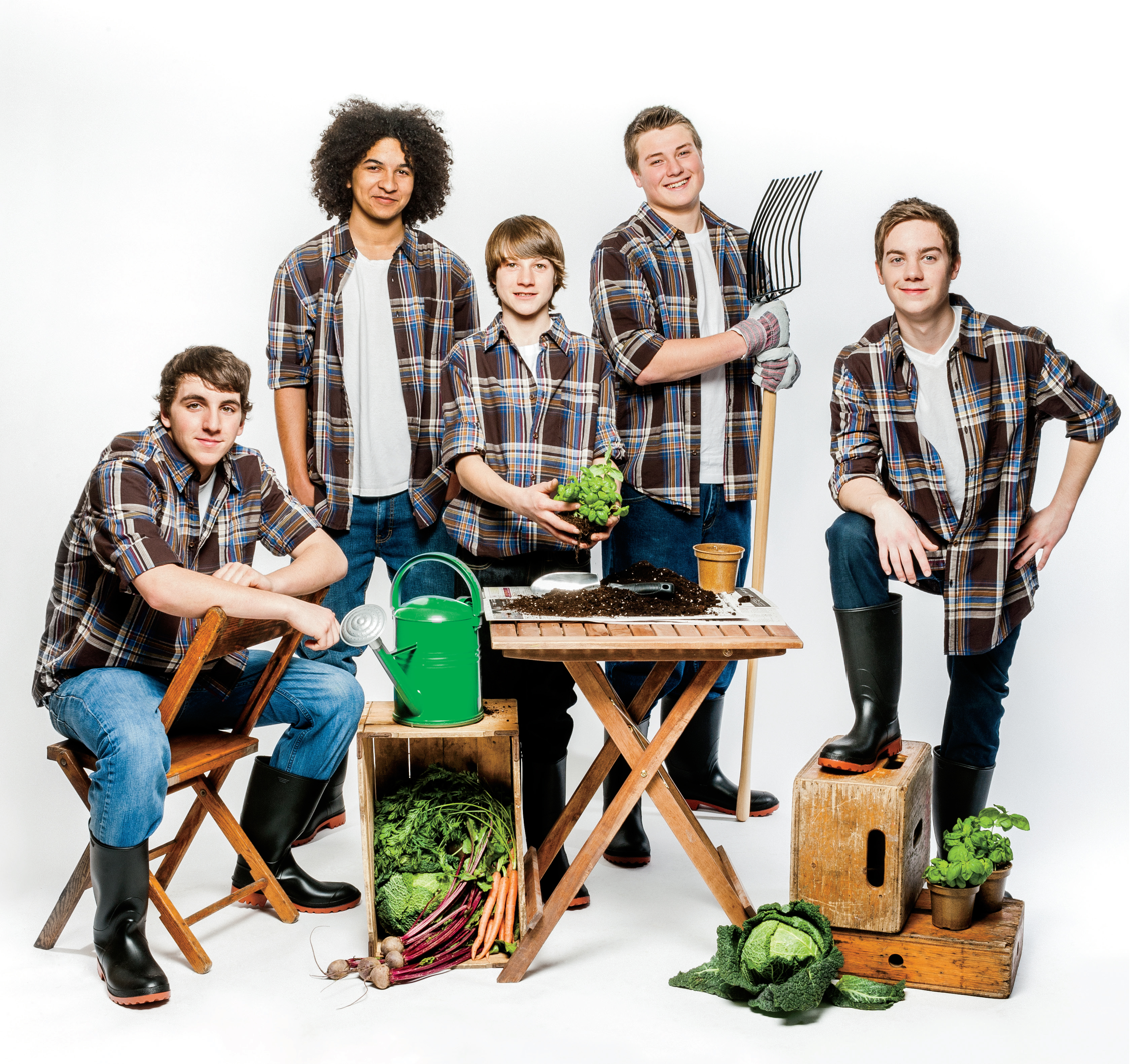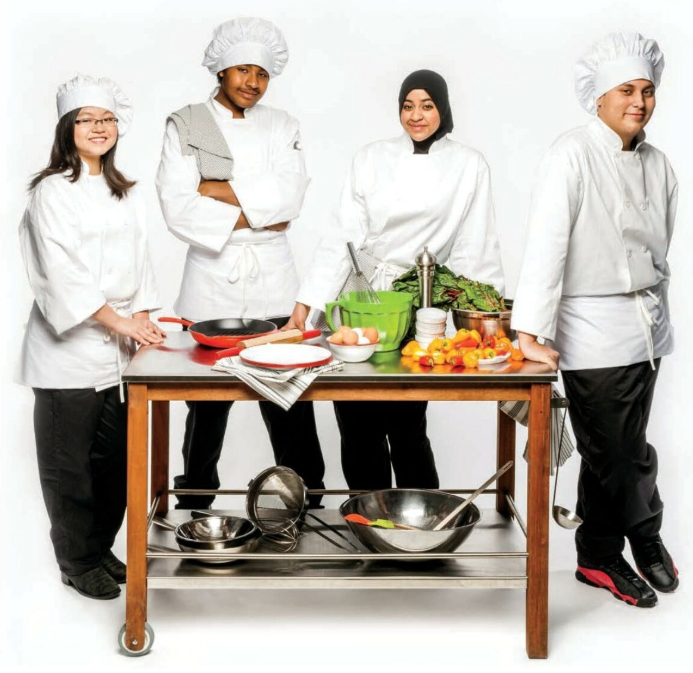Share this page
By Michael Benedict
Photos: Kevin Hewitt, Prop and Wardrobe Styling: Kate Curcio/Studio 141 Inc., Hair & Makeup: Michelle Rosen/Judy Inc.; Tree: iStock

Is Canada’s K–12 education system a match for the challenges posed by the 21st century? That was the leading issue Canadian educators and senior business executives addressed at a conference in Toronto last year. Answers varied.
Most speakers were skeptical, but one powerful voice, Linamar Corp. CEO Linda Hasenfratz, cited a successful Ontario high school program that produces graduates with the training and skills they need to compete for jobs. “The program works with the private sector...to create real-life experiences [for students],” Hasenfratz told the conference, Canada in the Pacific Century, organized by the Canadian Council of Chief Executives and the Canadian International Council. “How can it hurt to learn a skill that you can build on [later]?”
Hasenfratz was describing Ontario’s Specialist High Skills Major (SHSM) program, launched in 2006 and growing rapidly in scope and popularity. SHSM graduates have landed jobs of their choice or gone on to postsecondary training in fields where they have a leg up on their classmates. And both the students themselves and educators credit SHSM with engaging hard-to-reach students in their studies, even preventing dropouts. Sound impressive? What is it about SHSM that gives its grads an edge?
The program itself involves a package of Grade 11 and 12 courses and activities, including co-op, geared to one of 19 occupational areas, ranging from agriculture to transportation. SHSM embraces all education streams, preparing students for university, college, apprenticeship or the job market directly.
SHSM graduates and students embrace the program’s practical, hands-on experiential nature. “SHSM made me feel more connected to school,” says Josta Willebrand, a graduate of E.L. Crossley SS in Fonthill, Ont., and now an international business student at Brock University. “It gave me a focus and made me realize I wanted to pursue a business career.”
Today, Ontario has over 42,000 SHSM students, about 10 per cent of the Grade 11/12 total population, compared with just 600 in the program’s first year. Among the current SHSM crop are 50 Health and Wellness students at Lester B. Pearson CI, Toronto DSB. On this day, about a dozen of them are in a Grade 12 classroom, going through the paces of a first-aid exercise under the watchful eye of teacher Susan Moher, OCT, who is also a registered nurse.
The students work in pairs, taking turns treating a mock wound. A paper clip Scotchtaped to one teen’s arm represents a foreign object such as a nail or a shard of glass, while the other applies a dressing.
SHSM addresses a challenge faced by most North American schools — how to motivate students who are not engaged by the curriculum.
These students already have first-aid certificates from a community organization, but Moher says she wants to supplement that training with practical experience. “They know what they are supposed to do,” she adds, “but do they know how to do it?”
Moher’s classroom is a working lab that offers lots of how-to opportunities. There are four beds with mannequins as well as wheelchairs and other equipment so students can familiarize themselves with some basic health care activities. “I’m learning things I normally would not,” says Subitha as she treats Hajra’s “wound.” Subitha intends to study life sciences at Ryerson University, while Hajra is on her way to study neuroscience at the University of Toronto.
A few desks away, Cassandra has her eyes set on a career in early childhood education. She says being part of this SHSM, especially her co-op placement as a teacher’s assistant at an elementary school, helped her get accepted into a joint college/university apprenticeship program. Besides first aid, Cassandra also earned a CPR certificate through the SHSM program. “Kids do the unexpected,” she says. “With my CPR training, I now know what to do in such a situation.”
Helping students figure out a potential career path is one of the SHSM program’s key objectives. “It helps kids see the future,” says Tahira Irfan, OCT, responsible for administering SHSM at Lester B. Pearson CI. “So many of them are lost.”
Before a school board approves an individual school SHSM initiative, the school must work with the community to assess local job needs, develop relevant co-op placements and advise on the elements of the particular SHSM program. At Lester B. Pearson, Irfan also consulted the Parent School Council, which pressed for the health care option because of the field’s abundant career opportunities for children of recent immigrants, the bulk of the student body.
Next, Irfan recruited students to sign up. “The university-bound students were the first to jump on board,” she says. “But we went after students who didn’t know what they wanted; who we felt would do well with SHSM’s hands-on approach.”
Indeed, SHSM is designed to address a challenge faced by most North American schools — how to motivate students who are not engaged by the academic curriculum? “Our schools have done a good job when it comes to academics. But not nearly so well over the years with practical skills,” says Education Minister Liz Sandals. “SHSM addresses that need without forcing students into a strict vocational mould.”
Sandals adds that SHSM’s success is based on a recognition that students respond differently to the education system. “By the time kids reach high school,” she says, “they have an idea where their interests lie, but they need choices about learning styles.” SHSM offers the option to students to focus their studies and explore a future career, and it has changed some lives. At the same time, SHSM is designed to appeal to all education streams. “Traditionally, a skills approach ruled out university,” says Mary Jean Gallagher, an assistant deputy minister with the Student Achievement Division in the Ontario Ministry of Education, “but SHSM serves all paths. It’s intended to make school worthwhile for those who might be left behind and prepares all students for future success. It’s just as important to help kids who don’t go to university as it is those who do.”
A related SHSM goal is to improve the province’s high school graduation rate, and Sandals credits SHSM with being a factor in driving that number up from 68 to 83 per cent over the past decade. “Part of the reason for its success,” says Sandals, “is SHSM focuses on kids who might have struggled and now can see alternatives to the pure academic path.”
In addition to a mandatory co-op placement and taking courses in their program area, each SHSM student must meet other requirements to earn the Red Seal certificate awarded SHSM graduates. Plus, they have to earn relevant sector-recognized certifications in courses such as first aid and CPR. Students also visit workplace and postsecondary education sites and get in-school training from professionals in their chosen field. And they must demonstrate skills and work habits expected for their chosen sector, including how to present themselves at job interviews and proper manners in business-social situations.
The SHSM package “transforms the way students learn,” says Mark Hunt, OCT, principal of Ridgetown District HS in Ridgetown, Ont., Lambton Kent DSB. A big believer in the value of “authentic education,” Hunt is an avid SHSM cheerleader. “In the SHSM approach, knowledge information flows in both directions,” he says. “It could be an aspect of the ideal future for education, province-wide.”
Ridgetown serves a local Aboriginal community, and Hunt says an Arts and Culture SHSM aimed at this constituency has not only made Aboriginal students more engaged, but also has transformed the school. “Native and non-Native groups have a better understanding of each other as well as the parents and community members,” he explains. “It’s been a godsend.” The school’s other SHSM is in agriculture. “That’s a no-brainer because we are an agricultural community,” Hunt says.
Both programs are transforming the way students acquire knowledge and skills. “By interacting with non-educators, the students are developing new ways of learning,” says Hunt. “They bring back knowledge to the classroom, validating the outside learning experience and educating the teachers who then become co-learners. The kids obviously prefer that to just sitting and listening in the classroom. As the students gain knowledge, they breathe new life into the course materials. At the same time, their self-esteem goes up as well.”
All in all, these are useful educational outcomes, essential to handling those 21st-century challenges. Or as Linamar Corp.’s Hassenfratz put it: “We should have 100 per cent of the students go through that program. The worst case is that you learn something that can actually get you a job.”

“I was never one to like school,” says Bryan Boersma, who grew up on a farm. “I knew I wanted to farm eventually, and the opportunity to get more involved with the SHSM Agriculture program was definitely a bonus.”
Now that Boersma is attending the University of Guelph, the student adds: “I enjoyed those SHSM days and learned a lot that was directly related to what I wanted to do. It was amazing — nothing but a plus.”
As part of his course requirements, he obtained a pesticide-handling certificate — a welcome bonus. Says Boersma: “That’s huge for a farm kid."
– Bryan Boersma SHSM graduate, Ridgetown District HS, Lambton Kent DSB
Andrew Derynck wanted to pursue a music career, so one of his teachers recruited him into the school’s Arts and Culture SHSM. His co-op placement, helping a music teacher, sealed the deal. “It made me realize that teaching music is something I really wanted to pursue,” Derynck says
Derynck took part in a series of SHSM workshops including dance, singing, acting and comedy writing. “That exposed me to other aspects of music and to things I otherwise would not have done,” he says.
Currently, Derynck is in the B.Mus. program at Wilfrid Laurier University.
– Andrew Derynck SHSM graduate, Chatham-Kent SS, Lambton Kent DSB
Janelle says SHSM put her “on the right path” after she arrived in Canada from Jamaica in 2010. “I always wanted to go into nursing, and the guidance department persuaded me to enrol in the SHSM Health and Wellness program,” she says. “It enlightened me to the opportunities in the field.”
Janelle’s co-op placement was in a seniors’ home where she formed close bonds with the residents but also witnessed five people die. She ended up switching her interest to pediatrics.
“SHSM’s hands-on experience gets you thinking and solidifies what you want,” Janelle says.
– Janelle Grade 12 student, Lester B. Pearson CI, Toronto DSB
Before enrolling in his high school’s SHSM Hospitality and Tourism program, Joel Carmola-Chambers had no real goals. He parlayed his SHSM food preparation courses into a parttime job teaching adults at a cooking academy along with an apprenticeship at Humber College
“It was enlightening,” says Carmola-Chambers. “When I started the cooking class, it was to be with friends and get a credit. Then I learned where cooking could lead. Without SHSM, I wouldn’t have gone to college and probably would have ended up working at a warehouse without much of a future.
– Joel Carmolachambers SHSM graduate, Thistletown CI, Toronto DSB
Tyler Graham says the best part of SHSM is its impact on student achievement. “SHSM students are passionate about what they are doing, and we tailor the school day around their passions,” he says.
Graham meets three times a year with an advisory group of farmers and agribusinesses that helped him build an appropriate curriculum that is constantly being updated and revised. One requirement for all students: develop a business plan for a particular agricultural sector such as a dairy or chicken farm that requires them to visit the facility and interview the operators.
– Tyler Graham OCT, formerly Teacher and SHSM Agriculture Lead, South Lincoln HS, Smithville, DSB of Niagara (who now runs the SHSM Regional Horticulture Program in St. Catharines).